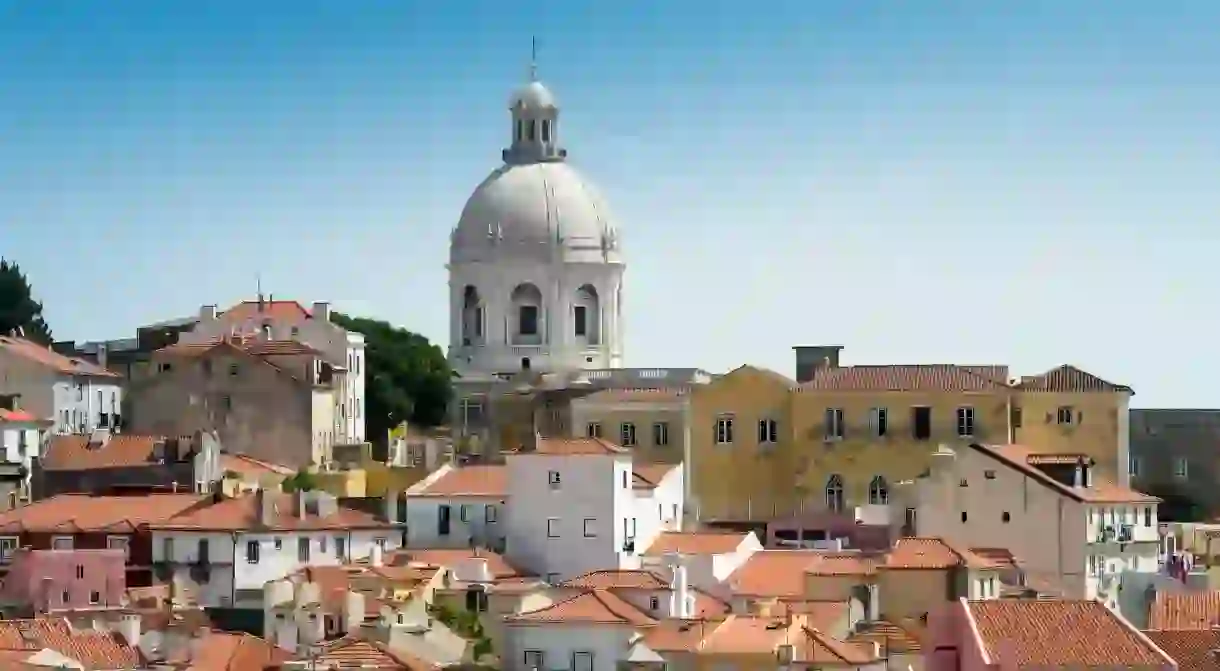An Architectural Tour of Alfama, Lisbon

Sitting astride seven hills, Lisbon is a city of many miradouros – lookout points that crest its high points and command arresting views. Perhaps the most uplifting of these are situated in the Alfama neighbourhood, which unfurls east of the city’s crowning glory of a Medieval fortress. This old Moorish quarter and its maze of narrow, twisting, cobblestone backstreets is the only district that emerged unscathed from the massive earthquake that rattled Lisbon back in 1755.
Here, the city moves at a slower pace, with washing strung between pastel-painted, azulejo-tiled houses, kids playing in the streets and steep steps leading to tucked-away plazas and fado (folk music) bars. Alfama’s charms haven’t gone unrecognised, and cool bars, cafés and restaurants are popping up here all the time – but in many ways this quarter remains the Lisbon that time forgot. If you’re into history and architecture in a big way, a stroll here is a must.
Sé
Cathedral, Church, Mosque

Igreja de Santo António
Church

Museu do Teatro Romano
Museum

Miradouro de Santa Luzia
Natural Feature, Architectural Landmark

A few minutes’ walk uphill brings you to this miradouro on Largo Santa Luzia, with a view out across the higgledy-piggledy Alfama quarter spilling down to the Tagus River. The lookout is named after the little whitewashed, 12th-century church that stands here, Igreja de Santa Luzia. Outside are ceramic panels of blue-and-white azulejos: the first depicts Saint Lucia, while the second shows Lisbon’s Praça do Comércio square before the earthquake struck in the 18th century, and the third portrays scenes from the 1147 Siege of Lisbon, when the Christians banished the Moors from the city.
Largo das Portas do Sol
Architectural Landmark

Just steps away you’ll come across the remains of the ‘Sun Gate’, one of the seven original gateways to the Moorish city. You’ll want to linger here now for the phenomenal views out over Alfama’s terracotta-tiled rooftops, domes and spires. Cross the street to visit the Fundação Ricardo do Espírito Santo (Largo das Portas do Sol), lodged in an exquisitely restored 17th-century town palace, Palácio Azurara. Its elegant, chandelier-lit rooms are filled with baroque azulejos, precious silverware, porcelain and other decorative arts.
Igreja de São Vicente da Fora
Church, Architectural Landmark

Before diving into Alfama’s tangle of back alleys, swing slightly north to one of Lisbon’s most striking architectural icons, the church and monastery of São Vicente da Fora, founded by Portugal’s first king, Afonso Henriques, for the Augustinian Order in 1147. King Philip II of Spain later gave it a complete makeover in 1580, drafting architects Juan Herrera and Filippo Terzi to build a mighty twin-towered church in the austere mannerist style of the late Renaissance. The monastery buildings and cloisters are just as impressive, lavishly decorated with 18th-century blue-and-white azulejo panels, including some playing out La Fontaine’s fables. Crusaders’ tombs lie beneath the polychrome marble sacristy.
Panteão Nacional
Architectural Landmark, Church

A five-minute wander from here brings you to the Campo de Santa Clara, where the Baroque National Pantheon demands attention, topped off with an enormous white dome that is visible from afar. Begun in 1681 and bearing the hallmark of the royal architect of the age, João Antunes, its Baroque design is architecturally unique, with a Greek cruciform floor plan, a high central dome and an echoing interior clad in polychrome marble. It’s a fitting final resting place for Portuguese presidents and bigwigs, and there are also cenotaphs to superstar explorers including Vasco da Gama and Henry the Navigator.
Igreja de São Miguel
Architectural Landmark

Now cut back into the lanes of the Alfama’s heart, ambling west along Rua dos Remédios to reach this bijou whitewashed church (Largo de São Miguel), with 12th-century origins. Its current look is Baroque-mannerist – simple on the outside, opulent on the inside, with gilded wood and 16 paintings attributed to 17th-century Portuguese painter Bento Coelho.
Casa dos Bicos
Architectural Landmark

From the church, head west along Rua São João da Praça, taking note of the remains of the old Moorish city walls, before veering south through the Arco de Jesus to Rua da Alfândega. Here you simply can’t miss the Casa dos Bicos (‘House of Spikes’), covered in 1,125 diamond-shaped points. Influenced by Portuguese Manueline and Italian Renaissance styles, the whimsical 16th-century edifice was built for Portuguese conqueror Afonso de Albuquerque. It now harbours the José Saramago Foundation, devoted to the Nobel Prize-winning Portuguese writer (1922-2010).
Memmo Alfama
Bar, Wine Bar, Portuguese, European













